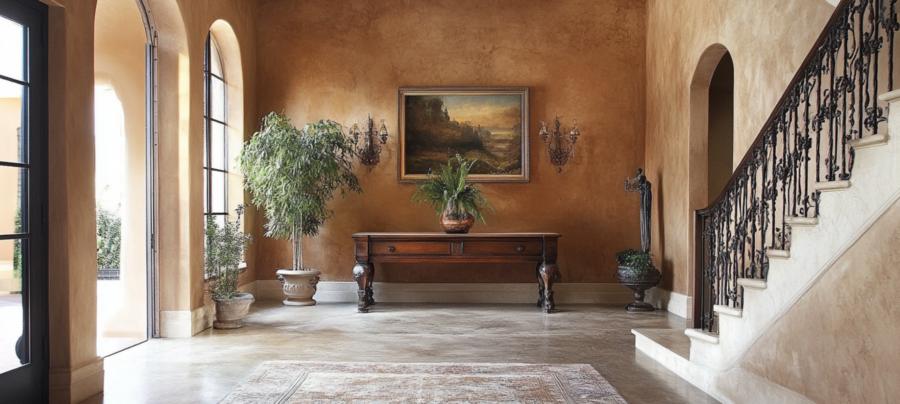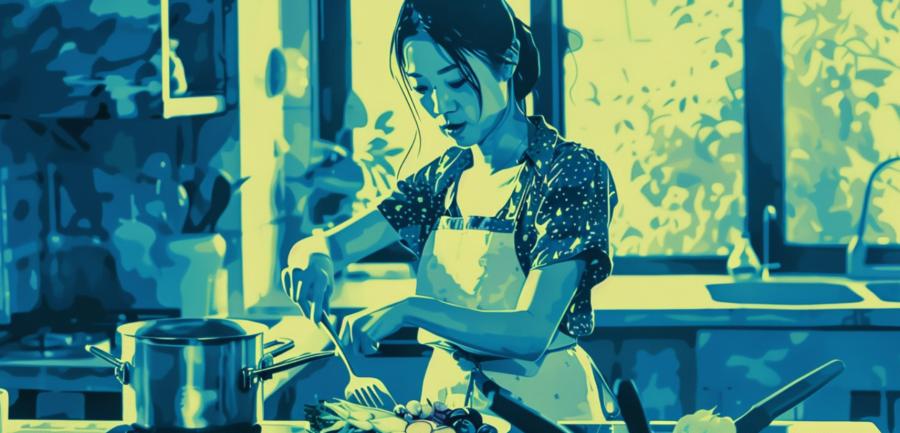Marble Magic: Turning Plaster into Stone
Nothing screams sophistication like marble, but real marble is heavy, expensive, and a nightmare to install unless you have a team of skilled artisans and a bank account that can take a serious beating. Faux marble, on the other hand, offers all the elegance without the hassle.What You’ll Need:
- A base coat of satin-finish paint (light gray, white, or cream)
- A few darker shades for veins (charcoal, slate, or soft gray)
- A sea sponge or feather
- A fine artist’s brush
- A spray bottle of water
- Glaze (to blend everything together)
- Paint the base coat and let it dry completely. This is non-negotiable—rushing this step leads to regret, and no one likes regret on their walls.
- Dampen your sea sponge, dip it into one of your darker shades, and dab randomly. Don’t overthink it—nature isn’t perfect, and your faux marble shouldn’t be either.
- Use the fine brush to paint thin, meandering veins, mimicking real marble patterns. If you accidentally create something that looks more like a map of ancient trade routes, lightly mist the area with water and blot with a sponge.
- Blend everything using a clear glaze. Apply it with a clean sponge to soften any harsh edges. Let it dry and admire your faux-luxurious masterpiece.
Rustic Wood: Because Planks Belong on Walls Too
Wood-paneled walls can add warmth and character to any space, but installing actual wooden planks is an exercise in endurance and a potential lesson in how quickly your patience wears thin. Luckily, you can get the same cozy, cabin-in-the-woods effect with just a little paint and an impressive ability to fake it.What You’ll Need:
- A base coat in a wood-like color (tan, beige, or soft brown)
- A few darker shades for wood grain (walnut, mahogany, or oak tones)
- A wood graining tool (or a stiff brush if you like living on the edge)
- Painter’s tape
- A glaze for blending
- Paint your wall with the base coat and let it dry completely. Yes, patience is a virtue.
- Use painter’s tape to mark off long, plank-like sections. This ensures your “wood” doesn’t end up looking like an abstract art piece gone wrong.
- Mix your darker shades with glaze to make them more transparent. Apply in streaks, dragging the wood graining tool or brush through the wet paint to create that signature wood texture.
- Remove the tape, step back, and marvel at your wooden illusion.
Fabric Effect: Walls with a Soft Touch
Not every wall needs to feel like, well, a wall. With the right techniques, you can create the effect of soft linen, woven silk, or even velvet. The trick? The right brushstrokes and a willingness to embrace imperfection.What You’ll Need:
- A base coat in the desired fabric color
- A glaze mixed with a slightly darker shade
- A wide brush or rag
- A steady hand (or an enthusiastic willingness to experiment)
- Paint the base coat and allow it to dry completely.
- Mix your glaze and apply it using crisscrossing strokes with a wide brush. This will mimic the irregular weave of fabric.
- If you want a silk-like effect, lightly drag a dry brush over the surface while the glaze is still tacky. This will give the wall a subtle sheen.
Faux Brick: Urban Charm Without the Construction
There’s something undeniably cool about exposed brick walls. They add texture, history, and a bit of industrial edge to any space. Unfortunately, not every home comes with century-old bricks just waiting to be unveiled. But with some well-placed paint and a steady hand, you can fake the look of brick without swinging a sledgehammer at your drywall.What You’ll Need:
- A base coat in mortar color (light gray or off-white)
- Brick-colored paint (terracotta, red, or brown)
- A rectangular sponge or stencil
- Painter’s tape (optional but helpful for precision)
- A small brush for touch-ups
- Paint the entire wall in your mortar color and let it dry.
- Using a rectangular sponge, dip it into the brick-colored paint and stamp it onto the wall in a staggered pattern. If using a stencil, tape it in place and dab the paint over it.
- Leave small gaps between the “bricks” to simulate mortar lines. If some stamps come out uneven, don’t panic—real brick is rarely perfect.
- Once dry, use a small brush to touch up any edges or add extra shading for depth.
Antique Patina: Because Aged Walls Tell Better Stories
New paint is nice, but aged walls have a certain charm. The problem is, waiting decades for your walls to develop that rich, timeworn character isn’t exactly practical. Thankfully, faux patina techniques can give you that centuries-old European villa aesthetic in just a few hours.What You’ll Need:
- A base coat in an earthy tone (warm beige, soft green, or muted blue)
- A few darker, complementary shades
- A sponge or rag
- Glaze for blending
- A spray bottle with water
- Paint the base coat and let it dry completely.
- Mix a small amount of your darker shade with glaze.
- Using a sponge or rag, blot the mixture onto random areas of the wall. Lightly spritz with water to help it blend.
- Repeat with different shades to build up layers of color, creating a naturally weathered look.
Metallic Sheen: Walls with a Luxurious Glow
If you want to go beyond traditional finishes and into something more eye-catching, metallic walls might be the answer. The right technique can create the illusion of brushed steel, antique gold, or shimmering bronze—no heavy metal sheets required.What You’ll Need:
- A base coat in a neutral color (black, charcoal, or deep brown work best)
- Metallic glaze or metallic paint
- A wide brush or soft cloth
- A dry sponge for blending
- Paint the wall with the base color and allow it to dry.
- Apply the metallic glaze in long, sweeping strokes using a wide brush or soft cloth.
- While still wet, use a dry sponge to soften any harsh lines, blending the metallic paint for a subtle, brushed effect.
- For extra depth, layer different metallic shades for a more dynamic finish.
A Faux-tastic Finale
Who knew walls could be this much fun? With a little paint, patience, and the ability to embrace imperfection, any room can be transformed into something extraordinary. Whether you’re faking marble, wood, fabric, or even metal, the key is layering, blending, and stepping back every so often to make sure you haven’t just created the world’s largest abstract painting by accident.Now go forth and trick your guests into believing you spent a fortune on your walls. Just don’t let them get too close—you wouldn’t want anyone poking at your “marble” and realizing it’s just good old drywall underneath.
Article kindly provided by albonspantinganddecorating.com.au


